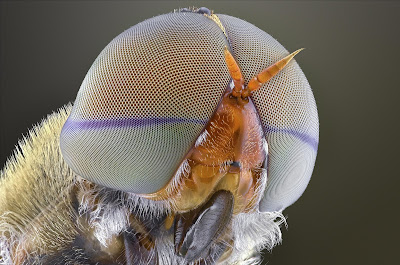 |
| Chameleon |
The eye without doubt is the primary organ to interact with
the world around us. More than eighty percent of our knowledge is acquired
through eye and its visual impact afterwards. Around 95 percent of animals have
eyes. Even one Hollywood movie has been entitled hills have eyes (!!!). And
literally speaking, a sprouting potato has got eyes!
1) Owl’s Eye
Nature is simply awesome; it has made each and every simple
detail to completely fit with each other. One’s deficit will be complimented by
another’s sufficiency. The owl can turn its head 180 degree rear from the front
either way; clock or anti-clock. This is simply because they can’t move their
eyes as they are deeply/tightly fitted in the socket. As both the eyes are in
the same plane and are directed in exact the same direction, these allow them
the maximum depth perception which is helpful in preying with accuracy.
2) Chameleon’s Eye
The chameleon from the Lizard family, well known as being
capable of color camouflage has got amazing eyes that can scan
a full 360 degrees; both the eyes being independent in movement. Moreover,
their whole eyeball is covered by lids with only a hole to see through.
3) Camel’s Eye
Despite the fact that all vertebrates have two eyelids, it
is definitely strange to know that camels have three instead. The internal one
does not have eyelashes unlike the outer ones. The camels can continue to walk
in the desert even in the time of sandstorm by closing the third lid which is
semi-transparent. This shuns the sand to enter into the eye while enabling it
to walk with available partial vision.
4) Hippopotamus’ Eye
The eye of hippopotamus has got a thin transparent layer of
membrane that protects the cornea from injury and water debris; this renders
hippos to see underwater without any obstacle with maximum precision. This
membrane is just like a natural swimming goggle for them.
5) Goat’s Eye
And the other interesting eye is of goat. They have quite a
rectangular pupil which enables extended horizontal visual field up to 320
degrees. These sorts of pupils also provides better night vision as the pupil
allows more of peripheral light to enter into off-center retina thereby
stimulating rod cells.
6) Cat’s Eye
Cat’s eye often glows in the dark. The eyes of prey animals
like cat also do. This is because beyond the retina they have a reflecting
membrane called tapetum lucidum which reflects the remaining portions of light after being
absorbed from retina. The reflected light is again absorbed by the retina and
finally pops out of the pupil that we see it glowing. The reflecting layer
hence provides effective night vision as obviously it renders light to be
absorbed twice by the retina. So, they can make out things even in scarce
light.
7) Arthropod’s Eye
Mammalian eyes are simple unlike those of some arthropods like housefly, dragonfly or ants; which have compound eyes or a combination of numerous ommatidia. That is: one compound eye consists of thousands of ommatidia and a single ommatidium consists of a cornea, lens and light sensing photoreceptor cells. It has a superior qualities to detect fast pacing objects than a single (like human) eye.
 |
| A pair of compound eyes with thousands of ommatidia |
8) Eagle’s Eye
If someone has an eagle’s eye then by this phrase we should
know that he or she has sharp vision. The visual acuity of an eagle’s eye is 4
to 8 times sharper than an ordinary human being. That is to say if an average
human has acuity of 6/6, then an eagle will have at least visual acuity of
6/1.5. An eagle can discriminate a moving rabbit from almost 5 kilometers (~3
miles) away. The capacity for color discrepancy in an eagle's eye is way more
than in humans. Eagle’s eye can even detect ultraviolet rays which our eyes are
unable to see.
9) Non-visual Eyes: Pit viper
& Bat
A pit viper snake has even thermal vision which means it can feel objects approaching or going by temperature variation rather than seeing. Some snakes detect moving objects by their protruding tongue which can feel the movement by vibration of air or land. Bats are blind but they can move equally at night and day, their movement is less at day time as there are various living creatures moving in the air at day that multiplies the possibility of accidents. They can detect the position of surrounding objects by emitting ultrasonic sound and analyzing the reflected sound. Then they move forward dodging the objects accordingly. Sometimes they die of electrocution in hanging wires because of their failure to analyze accurately the position of wire (which is thin to reflect the sonar effectively).
 |
| Green Pit viper with a lot of pits |
10)
Human Eyes
Unlike most of the animal’s eyes, human beings have region
of overlapping of the visual fields of each eye. This is the region of depth
perception or 3D vision i.e. relative placement of objects with respect to each
other or background and position of the eye. So, one-eyed person can’t enjoy 3D
movies. Sometimes, 3D vision is limited due to unilateral visual loss or
amblyopia or any opacity in the ocular media.
The new born human babies are color blind at birth, the
color perception develops over the first 6 months of their lives.
Bonus Information
Color vision of dogs, cats, rats, rabbits, etc., is
dichromatic with sparse diffused hues of other colors than black and white.
Bulls are color blind so in the game of bull-fighting the gladiator flashes red
clothing and bulls chase the movement not the color. Wasps can see the world in
only two colors, black and white. So since the contrast of black color
outstands that of any other colors, they tend to attack heads (black-haired
ones not Caucasians!). Bees and butterflies have extended perception of colors
than a normal human eye which ranges to even ultra-violet rays.
You can watch the 10 crazy eye facts in the following video as well which is in Nepali language.





0 Comments